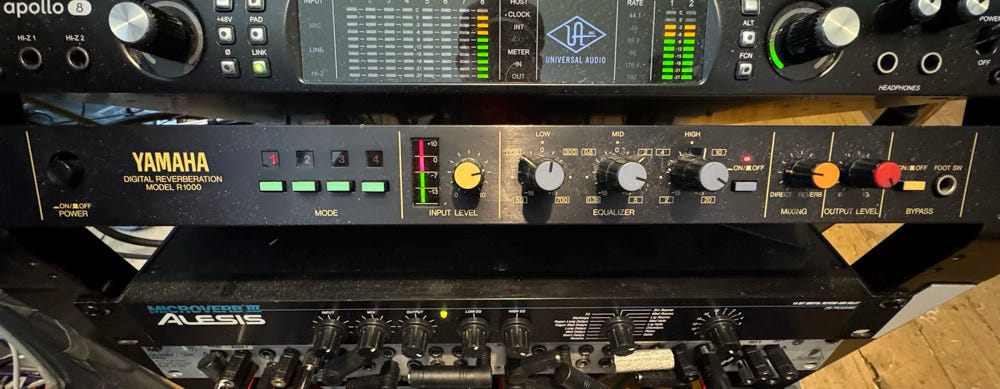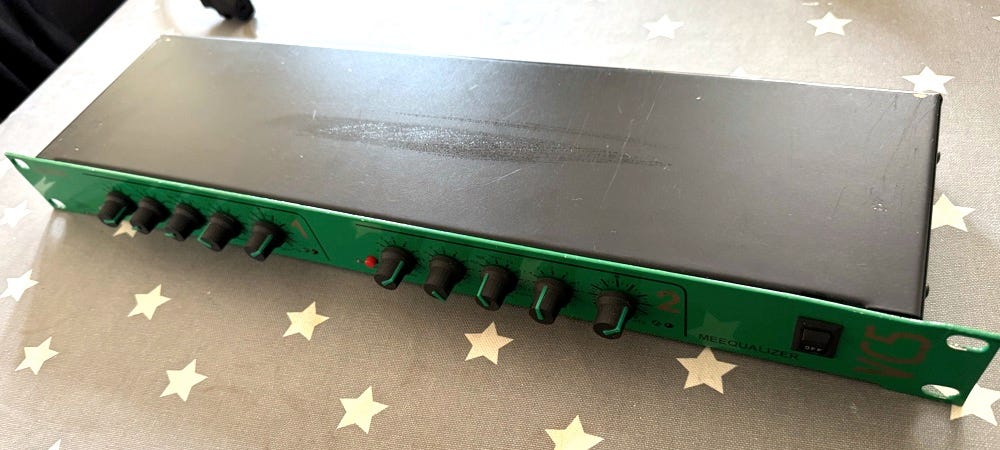Like most GAS powered producers I’ve always an eye on old pieces of kit - many of which can be found on eBay and Reverb for decent prices if you’re willing to take the time to hunt them down.
Over the past year or so my main vintage fascination has been with 80s and 90s rack FX which, after two decades of studio dominance, were mostly replaced by software in the 00’s.
Here’s my experience with four such units I bought, three of which have now left the studio and one new purchase that I think will be sticking around - as well as what the music tech press had to say at the time.
Yamaha R1000 Reverb (1984) - Digital Reverb
What the reviews said:
‘…the R1000 is excellent, and will serve you faithfully for all the standard, natural reverb requirements’
Home & Studio Recording, January 1984
My experience:
First impressions of this from the box was ‘wow, it’s pretty deep’ but not in terms of features - the thing is huge and actually took a ton of effort to get it into my rack.
Conversely, feature-wise it isn’t deep at - with just four preset reverb options available. The EQ offers some nice options in terms of tonal control but mostly I was left wondering what, even in 1984, all the internal space was being used for.
Oh - and it’s mono. Which I just can’t rationalise when it comes to reverb. At all.
It’s an early budget digital reverb and frankly I bought it more out of curiosity than to generate earth shattering sonic spaces but the limitations and size meant it wasn’t really feasible for the studio.
Joe Meek VC5 Meequaliser (1998) - 3 Band Dual EQ
What the reviews said:
‘The VC5 Meequaliser is a simple, straightforward 3‑band equaliser with a warm, natural sound. What it lacks in flexibility it makes up for in sonic charm’
Sound on Sound, May 1998
My experience:
I bought this mainly to add some analog warmth to my Waldorf Iridium, and to try out a hardware EQ for the first time in years since I’ve used UAD plugins for this for a while now.
It did a fairly good job of this but for some reason the treble really never seemed to sound anything but overly harsh to my ears - and certainly not the ‘natural’ sound that SOS suggested. Maybe that meant something else in the late 90s?
It did sell within minutes of being on eBay though so hopefully its new owner will enjoy it more.
Alesis Midiverb III - Stereo Digital FX unit (1990)
What the reviews said:
‘the Midiverb III, sounding a lot like the Midiverb II, really can't be faulted for basic sound quality. Smooth, with none of the tendency toward "ringiness" which mars a lot of reverb programs, it moves from small, live rooms to huge empty halls with consummate ease’
Music Technology, March 1990
My experience:
This one certainly is marred by the ‘ringiness’ in the reverbs, and so didn’t chime with me at all (pun intended). Everything else tended to sound quite dull coming out of the unit also, and while there is a basic onboard EQ it never really tweaked the frequencies needed and generally made things sound worse.
Ironically, I just discovered I’d previously owned and sold on one of these a few years back and then completely forgotten about it - and so having had the chance to impress me twice its failed twice!
Lexicon MPX100 - Stereo Digital FX Unit (1998)
What the reviews said:
As a main reverb processor, the MPX100 will more than satisfy most project studio requirements, in terms of both versatility and quality, and the fact that it offers other impressive effects too makes it a useful all‑rounder.
Sound on Sound, August 1998
My experience:
This recent purchase has taken the spot in my desktop rack originally filled by the Joe Meek and was bought for what seems like a ridiculously good price given its excellent condition.
The main objective with this one was as a replacement to my recently sold off Eventide pedals, which I used to handle outboard digital effects, but in truth never really got along with or ended up using on any tracks.
Have to say that, I like it so far and while obviously of its time and has some limitations the FX generally all sound pretty good for a piece of kit that is 27 years old. Also, being able to MIDI CC control parameters opens up some creative possibilities, for instance using the delay settings at 100% mix as a grainy sounding glitch effect, as demonstrated here.
And that’s it - four in, three gone.
I hope this has been an interesting read and a helpful perspective for anyone considering any of these rack units. Have you experienced similar with them - or disagree completely? Let me know in the comments as I’m always happy to talk about this stuff.






